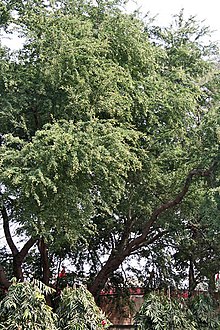
Back غاف البحر Arabic Pithecellobium dulce AST Pithecellobium dulce Bulgarian খইয়া বাবলা Bengali/Bangla Pithecellobium dulce Catalan Kamansilis CEB Pithecellobium dulce Spanish تمبر هندی مانیلا Persian Pithecellobium dulce French जंगल जलेबी Hindi
| Pithecellobium dulce | |
|---|---|

| |
| In Kolkata, West Bengal (India) | |

| |
| Ripe Pithecellobium dulce bean | |
| Scientific classification | |
| Kingdom: | Plantae |
| Clade: | Tracheophytes |
| Clade: | Angiosperms |
| Clade: | Eudicots |
| Clade: | Rosids |
| Order: | Fabales |
| Family: | Fabaceae |
| Subfamily: | Caesalpinioideae |
| Clade: | Mimosoid clade |
| Genus: | Pithecellobium |
| Species: | P. dulce
|
| Binomial name | |
| Pithecellobium dulce | |
Pithecellobium dulce, commonly known as Manila tamarind, Madras thorn, monkeypod tree or camachile,[4][5] is a species of flowering plant in the pea family, Fabaceae, that is native to the Pacific Coast and adjacent highlands of Mexico, Central America, and northern South America.[3] It is also sometimes known as monkeypod, but that name is also used for several other plants, including Samanea saman.[6] It is an introduced species and extensively naturalized in the Caribbean and Florida, as well as the Philippines and Guam via the Manila galleons. It has also been introduced to Cambodia, Thailand and South Asia,[7][8] It is considered an invasive species in Hawaii.
- ^ Botanic Gardens Conservation International (BGCI); IUCN SSC Global Tree Specialist Group (2019). "Pithecellobium dulce". IUCN Red List of Threatened Species. 2019: e.T130519803A149057978. doi:10.2305/IUCN.UK.2019-2.RLTS.T130519803A149057978.en. Retrieved 14 December 2022.
- ^ "Pithecellobium dulce Guama Americano". NatureServe Explorer. NatureServe. Retrieved 2020-01-10.
- ^ a b "Pithecellobium dulce". Germplasm Resources Information Network. Agricultural Research Service, United States Department of Agriculture. Retrieved 2010-03-29.
- ^ Hiwale, Shrikant (2015). "Non Traditional Crops: Manila Tamarind (Tamarindus indica L.)". Sustainable Horticulture in Semiarid Dry Lands: 273–277. doi:10.1007/978-81-322-2244-6_20. ISBN 978-81-322-2243-9.
- ^ "Camachile". The Free Dictionary. Retrieved 27 May 2020.
- ^ USDA, NRCS (n.d.). "Pithecellobium dulce". The PLANTS Database (plants.usda.gov). Greensboro, North Carolina: National Plant Data Team. Retrieved 6 October 2015.
- ^ Trimen, Henry (1894). Flora of Ceylon. Vol. 2. London: Dulau & Co. pp. 131–132. doi:10.5962/bhl.title.10864.
- ^ Khanzada, Samina Kabir; Kabir, Amina; Shaikh, Wazir; Ali, Syed Abid (April 2013). "Phytochemical studies on Pithecellobium dulce Benth. A medicinal plant of Sindh, Pakistan". Pakistan Journal of Botany. 45 (2): 557–561. Retrieved 19 July 2018.
© MMXXIII Rich X Search. We shall prevail. All rights reserved. Rich X Search

